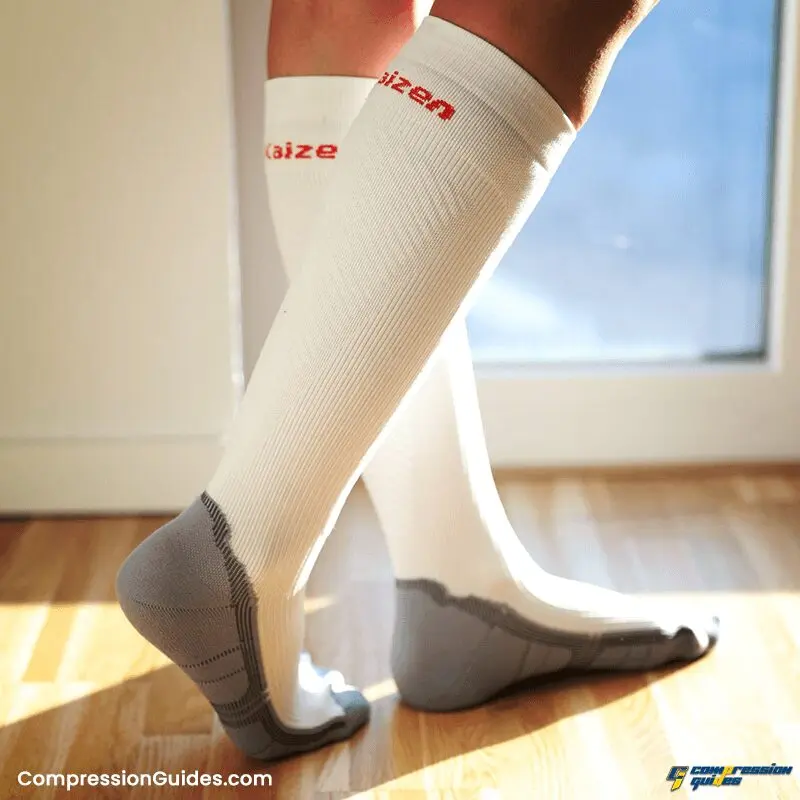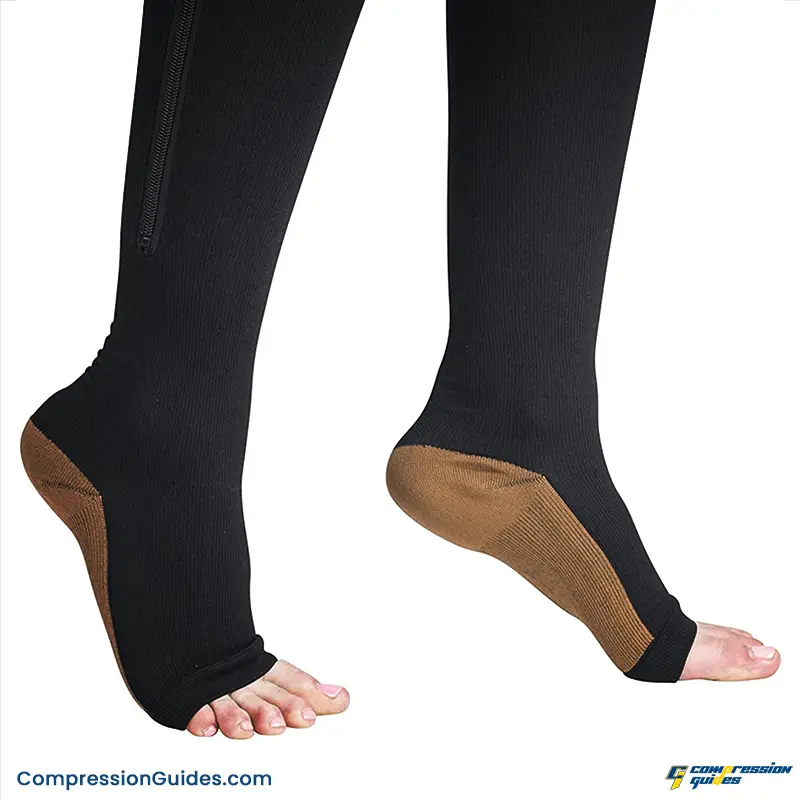Do you find it hard to wiggle your toes when you have compression socks or stockings on? Does your toe feel too tight and want to move around? Or do you skip compression stockings in the summer?
This guide will tell you everything about toeless and closed-toe compression socks stockings so you can choose which one is best for you. Keep Reading!
Closed Toe Compression Socks
Like standard socks, these socks cover your entire toes. However, closed-toe stockings provide full foot coverage and are more suitable for frequently wearing closed-toed shoes. These are also ideal if you want to wear additional gear to protect or cover your feet.

Compression thigh highs with closed-toes are better for colder months since the full coverage keeps you warm. They are best when worn with skirts and dresses in the Fall and Winter seasons.
Open Toe Compression Socks
You’ll enjoy open-toe compression stockings if you like some space for your toes or fancy wearing summer sandals. They’re perfect for you if you have toe issues like ingrown toenails, bunions, and open sores.
Open-toe compression stockings are made to give your ankle and foot some support and compression. They have a breathable fabric that lets your toes get some air. This makes them a cozy and fashionable choice for summer.
If your toes are hurting, open-toe compression stockings can ease your pain and swelling. They can also protect your toes from getting worse.
If you want a cozy and fashionable way to support your feet, open-toe compression stockings are a great option. They come in a variety of colors and styles to suit your needs.

Here are some additional tips for wearing open-toe compression stockings:
Medical Benefits Of Open Toe & Toeless Compression Stockings
Compression socks and stockings can relieve swollen feet and reduce edema. They also reduce the risk of lymphedema, DVT, and chronic venous disorders.
Doctors recommend open and closed stockings to treat varicose veins, phlebitis, inflammation, soreness, and blood clots. They are also helpful for people with swollen or painful feet or toes.
Diabetes patients can also benefit from compression socks. These socks provide special care for the lower legs and help protect the feet from wounds and minor injuries.
Features Of Toeless Compression Socks
When choosing open-toe compression socks, it is important to select a high-quality pair. The best compression socks are durable, comfortable, and effective.
Here are some of the features of open-toe compression socks:
If you are looking for a high-quality pair of open-toe compression socks, be sure to consider the features listed above. If you are looking for a comfortable, stylish, and versatile way to improve your circulation, toeless compression socks may be a good option for you.
Read: Compression Socks vs Compression Sleeves
When To Wear Toeless Compression Socks?
Here are some specific times when you may want to wear toeless compression socks:
Whether you have any toe conditions, feel discomfort or restrictions when using compression stockings, the open toe stockings will provide better freedom and allow greater movement of your toes.
How To Choose Between Open Toe and Toeless Compression Socks?
Both open and toe-closed stockings are beneficial to your leg health. Each will benefit you in some way, but which one will be most beneficial to you?
Here’s how to decide if open toe or toeless compression socks are right for you:
Check this video below for a more clear explanation:
Here are the major benefits of each of them that will help you make your final decision.
| Key Differences Between Toeless And Closed Socks | ||
|---|---|---|
| Feature | Open Toe | Close Toe |
| Foot Coverage | Toes are not covered | Toes are covered |
| Ventilation | Better ventilation | Less ventilation |
| Shoe Compatibility | More compatible with sandals and flip-flops. | More compatible with closed-toe shoes. |
| Comfort | More comfortable in warm weather | Comfortable in cold weather |
| Medical Benefits | Same For Both | |
Read: The Ultimate Guide on Choosing The Right Compression Socks
Also Check Out Our Reviews:
10 Best Compression Socks For Men in 2023 – [Reviews + Guide]
7 Best Hiking Compression Socks – [Reviews + Guide]
12 Best Nursing Compression Socks – [Reviews + Guide]
Frequently Asked Questions
Can I Cut The Toes Of My Compression Stockings?
No! It is not recommended that you alter or cut your stockings. Cutting off the toe will cause them to roll up, and they will become uncomfortable. If your stockings are too stiff around your toes, you should consider wearing open-toe stockings.
Conclusion
To sum things up, know that closed-toe socks cover your toes and keep you warm. Whereas, open-toe socks leave your toes free and let you wear sandals. Both socks help your blood flow and reduce swelling. Choose the socks that fit your feet and lifestyle and Don’t cut the toes of your stockings.


